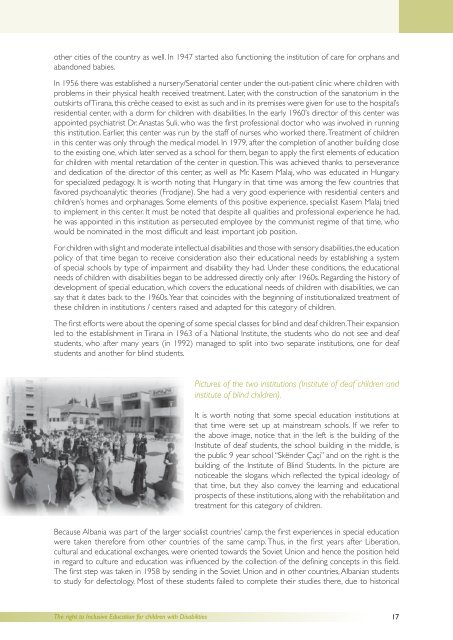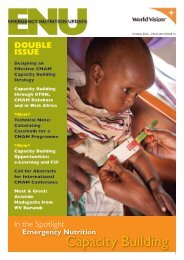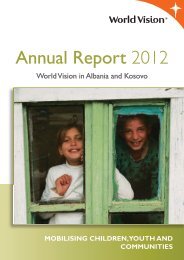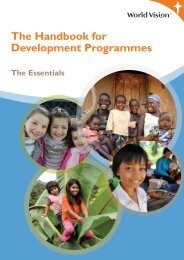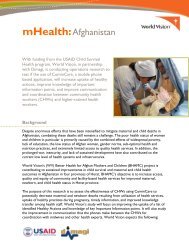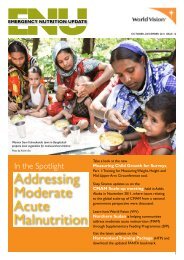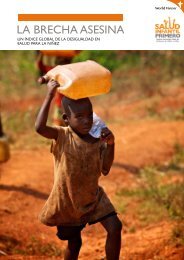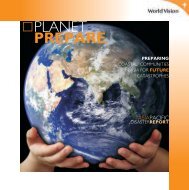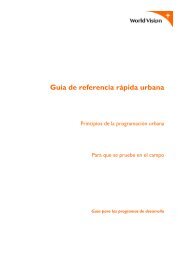Phase one: This phase includes <strong>the</strong> 50 year period of Albanian dicta<strong>to</strong>rship, a period during whichAlbania was under <strong>the</strong> dicta<strong>to</strong>rial regime and that continues <strong>to</strong> <strong>the</strong> early 90’s. We can say that Albaniahas inherited from <strong>the</strong> past a mentality which did not favor in any aspect <strong>the</strong> treatment and <strong>education</strong> ofdisabled <strong>children</strong>. This mentality stemmed from a low social and cultural level that characterized families,society and ultimately politics of that time. These three important elements have affected <strong>children</strong>’s <strong>with</strong><strong>disabilities</strong> treatment, evaluation, and <strong>education</strong> during this period. In many areas, birth of a disabled childwas considered a curse or a punishment from God and as a result <strong>the</strong> family members felt intimidatedby <strong>the</strong> society, inferior, and prejudiced. For many families having a child <strong>with</strong> <strong>disabilities</strong>, was considered ashame and damnation from God. These <strong>children</strong> were kept isolated at home, “away from <strong>the</strong> public eye”,away from <strong>the</strong> community. Family was <strong>the</strong> only institution that ensured care <strong>for</strong> <strong>the</strong> <strong>children</strong> <strong>with</strong> <strong>disabilities</strong>during this period.Under <strong>the</strong>se conditions, <strong>the</strong>re was nei<strong>the</strong>r medical and psychosocial treatment, nor let alone disabled<strong>children</strong>’s rehabilitation and <strong>education</strong>. On <strong>the</strong> o<strong>the</strong>r hand <strong>the</strong> society, <strong>with</strong> its attitudes and behaviors,prejudices, stereotyping, indifference, discrimination, and exclusion of <strong>the</strong>se <strong>children</strong> and <strong>the</strong>ir families, hasexacerbated and aggravated <strong>the</strong>ir predicament a great deal.Of course this situation just described could have not been different, given <strong>the</strong> state policy of that time.There was no social policy that directly supported and favored disabled <strong>children</strong>. Albanian society of thattime was not a welcoming society <strong>to</strong> <strong>the</strong> disabled <strong>children</strong>. Disabled <strong>children</strong> were objects of people’spity, or of some charitable or benevolent acts. During 1950 <strong>to</strong> 1970, a network of care institutions <strong>for</strong>individuals <strong>with</strong> <strong>disabilities</strong> was established as a response <strong>to</strong> <strong>the</strong>ir needs <strong>for</strong> medical treatment and care. In<strong>the</strong>se institutions, medical care was provided. The status of <strong>the</strong>se individuals changed from being completelyexcluded and denigrated, <strong>to</strong> a condition in which <strong>the</strong>y were “treated” and “considered” as persons entitled<strong>to</strong> help. This was an important starting point in <strong>the</strong> his<strong>to</strong>ry of <strong>the</strong> care <strong>for</strong> <strong>children</strong> and youth <strong>with</strong> <strong>disabilities</strong>.But <strong>the</strong>ir social needs and <strong>the</strong> <strong>right</strong> <strong>to</strong> <strong>education</strong>, were unfamiliar matters <strong>for</strong> <strong>the</strong> state policy of that time.Ano<strong>the</strong>r <strong>to</strong>pic <strong>for</strong> discussion is <strong>the</strong> issue pertaining evaluation and categorization of <strong>children</strong> <strong>with</strong> <strong>disabilities</strong>.Their categorization has its roots grounded deep <strong>with</strong>in this complex state apparatus. Practices used <strong>for</strong><strong>the</strong> institutionalization of <strong>the</strong>se individuals and <strong>the</strong> language used <strong>for</strong> naming <strong>the</strong>m, were mostly guided by<strong>the</strong> medical model perspective.as <strong>for</strong> <strong>the</strong> situation of <strong>education</strong> of <strong>the</strong>se <strong>children</strong>, we can say that <strong>the</strong> issues relating <strong>to</strong> <strong>the</strong>ir<strong>education</strong> until <strong>the</strong> 1970’s were not communist government priorities. After World War II, <strong>the</strong> newgovernment in Albania <strong>with</strong> features of <strong>the</strong> dicta<strong>to</strong>rship of <strong>the</strong> proletariat, enhanced <strong>with</strong> determinationits political program of building a socialist state of Stalinist type. This power, <strong>with</strong> its peculiar characteristicsand definition of new political course are reflected throughout <strong>the</strong> <strong>education</strong>al system, in particular in itsphysiognomy in this period, also called <strong>the</strong> first stage of <strong>the</strong> Albanian Socialist School (1945 - 1950). Therewere two basic pillars of <strong>the</strong> socialist course in Albanian schools: <strong>the</strong> social aspect, creating a massive school,aiming at bringing out <strong>the</strong> country from <strong>the</strong> underlying <strong>education</strong>al backwardness and in political terms, <strong>the</strong>creation of a school used as an instrument in <strong>the</strong> hand of <strong>the</strong> government, <strong>for</strong> building this new social order.Obviously, <strong>the</strong> needs of <strong>children</strong> <strong>with</strong> <strong>disabilities</strong> <strong>to</strong> be educated or involved in society, were not in <strong>the</strong> focusof <strong>the</strong> <strong>education</strong>al policy of <strong>the</strong> time. Problems and <strong>the</strong>ir needs were viewed only through <strong>the</strong> medicalmodel of disability, giving importance <strong>to</strong> <strong>the</strong>ir institutionalized treatment in hospitals or in caring centers.Problems of <strong>children</strong> and individuals <strong>with</strong> <strong>disabilities</strong> and <strong>the</strong>ir solution or addressing were sole responsibilityof <strong>the</strong> Ministry of Health and <strong>the</strong> institutions that were dependent from it. “Sick”, “stupid”, “flawed” <strong>children</strong>were thus diagnosed as <strong>children</strong> <strong>with</strong> <strong>disabilities</strong> in this period and were sent <strong>to</strong> hospitals or centers thatwere very similar <strong>to</strong> psychiatric hospitals. In <strong>the</strong>se centers–hospitals, <strong>the</strong>re were placed <strong>children</strong> <strong>with</strong> mental<strong>disabilities</strong>, and those <strong>with</strong> severe physical conditions, that were abandoned by <strong>the</strong>ir families. Children<strong>with</strong> multiple <strong>disabilities</strong> and grave intellectual <strong>disabilities</strong> were considered ineducable, so <strong>the</strong>re were noconsiderations of including <strong>the</strong>m in <strong>education</strong>al institutions. They were placed in centers or residentialhomes or isolated in <strong>the</strong>ir homes, <strong>with</strong>out any contact or relationship <strong>with</strong> <strong>the</strong> outside world.Pursuant <strong>to</strong> <strong>the</strong> state policy of <strong>the</strong> time, in 1945, in Tirana was established <strong>the</strong> orphanage <strong>for</strong> school <strong>children</strong>orphans, which was a continuation of “Malet Tona” boarding school. Later, this initiative was undertaken in16 The <strong>right</strong> <strong>to</strong> Inclusive Education <strong>for</strong> <strong>children</strong> <strong>with</strong> Disabilities
o<strong>the</strong>r cities of <strong>the</strong> country as well. In 1947 started also functioning <strong>the</strong> institution of care <strong>for</strong> orphans andabandoned babies.In 1956 <strong>the</strong>re was established a nursery/Sena<strong>to</strong>rial center under <strong>the</strong> out-patient clinic where <strong>children</strong> <strong>with</strong>problems in <strong>the</strong>ir physical health received treatment. Later, <strong>with</strong> <strong>the</strong> construction of <strong>the</strong> sana<strong>to</strong>rium in <strong>the</strong>outskirts of Tirana, this crèche ceased <strong>to</strong> exist as such and in its premises were given <strong>for</strong> use <strong>to</strong> <strong>the</strong> hospital’sresidential center, <strong>with</strong> a dorm <strong>for</strong> <strong>children</strong> <strong>with</strong> <strong>disabilities</strong>. In <strong>the</strong> early 1960’s direc<strong>to</strong>r of this center wasappointed psychiatrist Dr. Anastas Suli, who was <strong>the</strong> first professional doc<strong>to</strong>r who was involved in runningthis institution. Earlier, this center was run by <strong>the</strong> staff of nurses who worked <strong>the</strong>re. Treatment of <strong>children</strong>in this center was only through <strong>the</strong> medical model. In 1979, after <strong>the</strong> completion of ano<strong>the</strong>r building close<strong>to</strong> <strong>the</strong> existing one, which later served as a school <strong>for</strong> <strong>the</strong>m, began <strong>to</strong> apply <strong>the</strong> first elements of <strong>education</strong><strong>for</strong> <strong>children</strong> <strong>with</strong> mental retardation of <strong>the</strong> center in question. This was achieved thanks <strong>to</strong> perseveranceand dedication of <strong>the</strong> direc<strong>to</strong>r of this center, as well as Mr. Kasem Malaj, who was educated in Hungary<strong>for</strong> specialized pedagogy. It is worth noting that Hungary in that time was among <strong>the</strong> few countries thatfavored psychoanalytic <strong>the</strong>ories (Frodjane). She had a very good experience <strong>with</strong> residential centers and<strong>children</strong>’s homes and orphanages. Some elements of this positive experience, specialist Kasem Malaj tried<strong>to</strong> implement in this center. It must be noted that despite all qualities and professional experience he had,he was appointed in this institution as persecuted employee by <strong>the</strong> communist regime of that time, whowould be nominated in <strong>the</strong> most difficult and least important job position.For <strong>children</strong> <strong>with</strong> slight and moderate intellectual <strong>disabilities</strong> and those <strong>with</strong> sensory <strong>disabilities</strong>, <strong>the</strong> <strong>education</strong>policy of that time began <strong>to</strong> receive consideration also <strong>the</strong>ir <strong>education</strong>al needs by establishing a systemof special schools by type of impairment and disability <strong>the</strong>y had. Under <strong>the</strong>se conditions, <strong>the</strong> <strong>education</strong>alneeds of <strong>children</strong> <strong>with</strong> <strong>disabilities</strong> began <strong>to</strong> be addressed directly only after 1960s. Regarding <strong>the</strong> his<strong>to</strong>ry ofdevelopment of special <strong>education</strong>, which covers <strong>the</strong> <strong>education</strong>al needs of <strong>children</strong> <strong>with</strong> <strong>disabilities</strong>, we cansay that it dates back <strong>to</strong> <strong>the</strong> 1960s. Year that coincides <strong>with</strong> <strong>the</strong> beginning of institutionalized treatment of<strong>the</strong>se <strong>children</strong> in institutions / centers raised and adapted <strong>for</strong> this category of <strong>children</strong>.The first ef<strong>for</strong>ts were about <strong>the</strong> opening of some special classes <strong>for</strong> blind and deaf <strong>children</strong>. Their expansionled <strong>to</strong> <strong>the</strong> establishment in Tirana in 1963 of a National Institute, <strong>the</strong> students who do not see and deafstudents, who after many years (in 1992) managed <strong>to</strong> split in<strong>to</strong> two separate institutions, one <strong>for</strong> deafstudents and ano<strong>the</strong>r <strong>for</strong> blind students.Pictures of <strong>the</strong> two institutions (Institute of deaf <strong>children</strong> andinstitute of blind <strong>children</strong>).It is worth noting that some special <strong>education</strong> institutions atthat time were set up at mainstream schools. If we refer <strong>to</strong><strong>the</strong> above image, notice that in <strong>the</strong> left is <strong>the</strong> building of <strong>the</strong>Institute of deaf students, <strong>the</strong> school building in <strong>the</strong> middle, is<strong>the</strong> public 9 year school “Skënder Çaçi” and on <strong>the</strong> <strong>right</strong> is <strong>the</strong>building of <strong>the</strong> Institute of Blind Students. In <strong>the</strong> picture arenoticeable <strong>the</strong> slogans which reflected <strong>the</strong> typical ideology ofthat time, but <strong>the</strong>y also convey <strong>the</strong> learning and <strong>education</strong>alprospects of <strong>the</strong>se institutions, along <strong>with</strong> <strong>the</strong> rehabilitation andtreatment <strong>for</strong> this category of <strong>children</strong>.Because Albania was part of <strong>the</strong> larger socialist countries’ camp, <strong>the</strong> first experiences in special <strong>education</strong>were taken <strong>the</strong>re<strong>for</strong>e from o<strong>the</strong>r countries of <strong>the</strong> same camp. Thus, in <strong>the</strong> first years after Liberation,cultural and <strong>education</strong>al exchanges, were oriented <strong>to</strong>wards <strong>the</strong> Soviet Union and hence <strong>the</strong> position heldin regard <strong>to</strong> culture and <strong>education</strong> was influenced by <strong>the</strong> collection of <strong>the</strong> defining concepts in this field.The first step was taken in 1958 by sending in <strong>the</strong> Soviet Union and in o<strong>the</strong>r countries, Albanian students<strong>to</strong> study <strong>for</strong> defec<strong>to</strong>logy. Most of <strong>the</strong>se students failed <strong>to</strong> complete <strong>the</strong>ir studies <strong>the</strong>re, due <strong>to</strong> his<strong>to</strong>ricalThe <strong>right</strong> <strong>to</strong> Inclusive Education <strong>for</strong> <strong>children</strong> <strong>with</strong> Disabilities17


